Expanding Horizons: Enhancing Bird Life Beyond Cages

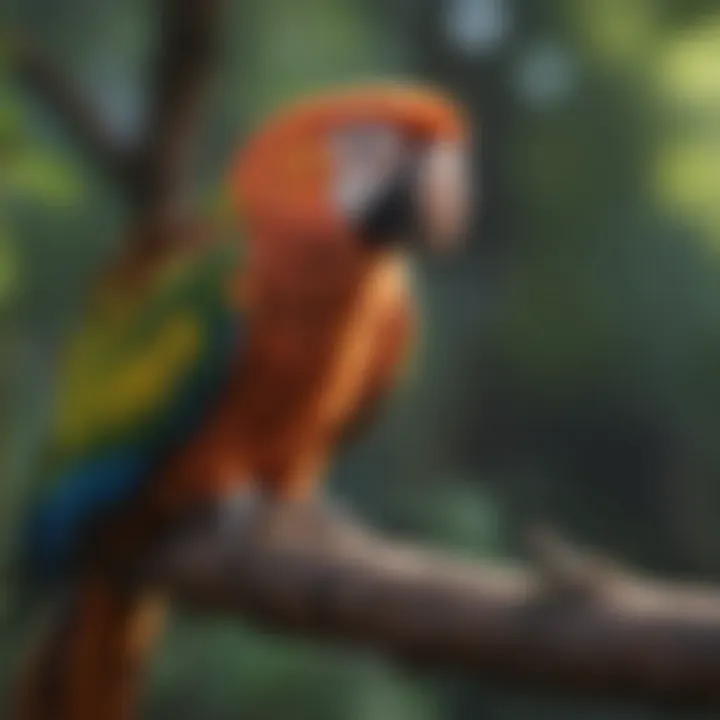
Intro
The world of pet bird ownership involves responsibilities that go beyond feeding and providing shelter. Engaging your bird with its environment is key to its overall well-being. This article will navigate through the different factors that contribute to maximizing the quality of life for your feathered companions. By considering aspects such as physical exercise, psychological enrichment, and the potential risks involved, bird owners can create a more fulfilling experience for their pets.
Birds are intelligent creatures that thrive on mental stimulation and physical activity. Their needs extend far beyond the limitations of a cage. This intro serves as a foundation for discussing various care strategies, behavioral insights, nutritional guidance, wellness tips, and enriching activities that can significantly improve life outside the cage. Each section will present practical advice, enabling pet owners to make informed decisions that enhance the daily lives of their birds.
Care Tips
Daily Care Routines
Establishing a daily care routine is essential for a bird's health and happiness. This includes regular feeding, cleaning, and social interaction. Every day, ensure that your bird has access to fresh water and a balanced diet. Routine feeding not only maintains a healthy weight but also reinforces trust between bird and owner.
Cage Setup and Maintenance
Setting up the cage correctly affects your bird's quality of life. A spacious cage equipped with perches, toys, and safe materials encourages exploration and exercise. Regular maintenance prevents build-up of waste and reduces the risk of illness for your pet. Clean cages promote a healthier environment.
Hygiene and Cleaning Practices
Hygiene is critical in bird care. Ensure that all food and water containers are washed regularly. Use mild, non-toxic cleaning agents to maintain a clean living area. Regularly inspect the cage for any condition that could lead to health issues.
Seasonal Care Adjustments
Changes in seasons may require adaptations in care. Ensure that your bird is not exposed to extreme temperatures. During warmer months, provide ample shade and access to fresh water. In colder months, consider sources of heat, but also ensure that these are safe and not harmful to your pet.
Behavioral Insights
Understanding Bird Body Language
Understanding how birds communicate through body language is vital for pet owners. Signs of contentment include chirping and relaxed body posture. Conversely, fluffed feathers or aggressive behavior may indicate distress.
Common Behavioral Issues and Solutions
Birds may exhibit issues like screaming or biting. Identifying the root causes, such as boredom or fear, will help in addressing these problems effectively. This may involve providing ample social interaction and mental stimulation.
Positive Reinforcement Techniques
Training using positive reinforcement can strengthen the bond between owner and bird. Use treats or praise to encourage desired behaviors, which can help in managing bad habits.
Social Interaction Needs
Birds are social creatures. Interaction with their owners or even other birds fosters emotional wellness. Regular, gentle handling can enrich their lives, reducing stress and anxiety.
Nutrition Guides
Essential Diet Components
A balanced diet is crucial for a bird’s health. Most pet birds thrive on a mixture of pellets, seeds, and fresh fruits and vegetables. Understanding the specific dietary needs of your bird species promotes better health.
Safe and Toxic Foods
Knowing which foods are safe is important. Commonly safe items include apples, carrots, and leafy greens; however, some foods like avocados and chocolate are toxic. Always keep this information accessible.
Supplements and Treats
Consider using nutritional supplements if your bird's diet lacks certain elements. Occasional treats can motivate and enrich their lives; however, moderation is key to avoid obesity.
Feeding Strategies for Different Species
Different species have diverse nutritional requirements. Research the specific needs for your bird, as this can affect their overall well-being.
Wellness and Health
Routine Health Checkups
Routine checkups with an avian vet ensure your bird remains healthy. Regular examinations can catch health issues before they become serious.
Identifying Symptoms of Illness
Be observant of changes in your bird’s behavior, appetite, or droppings. Identifying symptoms early on can lead to better health outcomes.
Preventative Care and Vaccinations
Preventative care, including recommended vaccinations, is necessary for a long and healthy life. Ensure that you are informed about your avian vet's guidelines.
Mental and Emotional Well-being
Mental health is equally important. Engage your bird daily, providing opportunities for social interaction and cognitive challenges.
Enriching Activities
Toys and Playtime Ideas
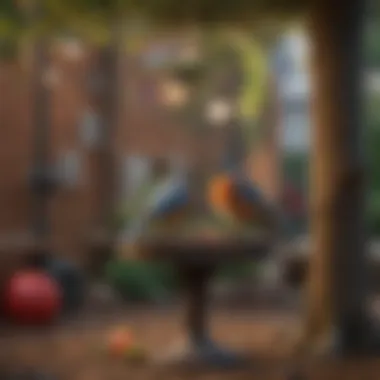
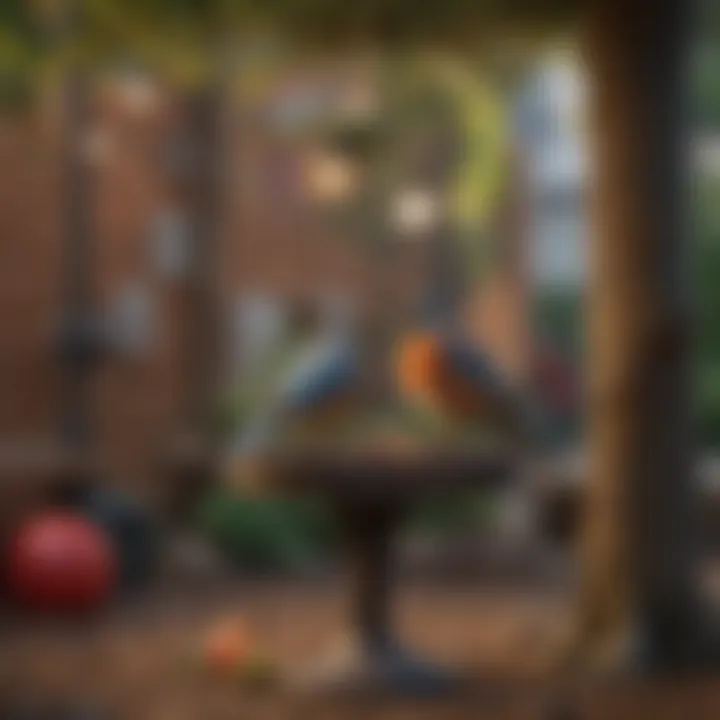
Incorporating a variety of toys will satisfy a bird’s natural instincts. Rotate toys regularly to keep their environment stimulating.
Training and Tricks
Teaching tricks can promote mental exercise and strengthen the bond between you and your bird. Use short sessions to keep their attention focused.
Outdoor Activities and Interaction
Allowing your bird supervised access to the outdoors can greatly enrich their life. Fresh air and new sights provide valuable stimulation.
DIY Projects for Mental Stimulation
Creating DIY toys or puzzles from safe household materials can stimulate your bird mentally. This provides an engaging way for them to explore and play.
"Life outside the cage can offer your feathered friends unparalleled opportunities for enrichment and engagement."
By understanding and implementing these various aspects of bird care, owners can significantly enhance their pets' quality of life. Each step taken towards better care contributes to a happier, healthier bird, ready to explore its surroundings with curiosity.
Understanding Avian Behavior
Understanding avian behavior is a fundamental aspect of caring for pet birds. It informs how we can best meet their needs and enrich their lives outside of confinement. Birds are naturally predisposed to explore their surroundings, seeking mental and physical stimulation. Recognizing these instincts helps bird owners create environments that mimic their natural habitats, allowing for healthier and happier pets.
An understanding of avian behavior sheds light on the significance of providing time outside the cage. Birds flourish when they have the opportunity to engage with their environment. Such exploration supports not just their physical health but also enhances their psychological well-being. Ultimately, understanding these behaviors lays the foundation for responsible pet ownership.
Natural Instincts
Birds exhibit a range of natural instincts that inform their actions. These include foraging, nesting, and social behaviors. Foraging, in particular, is essential for their survival in the wild. This instinct is rooted deeply in their biology. When birds are allowed outside the cage, they can engage in foraging activities, which can be replicated using puzzle toys and hiding food.
Moreover, nesting instincts drive many species to seek safe and secure spaces. Recognizing this can guide owners in providing appropriate nesting materials and areas when birds are allowed out. By acknowledging such behaviors, pet owners can tailor their environments to meet the innate needs of their birds. This not only fosters a sense of safety but also ensures that the bird’s behavioral health is prioritized.
Exploration and Curiosity
Curiosity drives birds to explore. This instinct leads them to investigate different elements of their surroundings. Allowing a bird room to explore cultivates its natural tendencies and enhances its cognitive functions. Exhibiting curiosity can reduce stress as the bird engages its environment actively. Furthermore, exposure to various stimuli can foster adaptability, allowing birds to thrive.
When birds venture outside their cages, they can encounter new sights, sounds, and textures, enriching their lives. This constant exploration supports their mental health by decreasing boredom and preventing destructive behaviors. Owners can facilitate this curiosity by rotating toys, introducing new perches, or even altering their home's layout to present fresh exploration opportunities.
To summarize, understanding avian behavior is pivotal in providing a fulfilling life for pet birds. Recognizing natural instincts and encouraging exploration play significant roles in their overall health and happiness.
Benefits of Time Outside the Cage
Engaging pet birds in activities outside the cage is not merely a luxury; it is essential for their well-being. Time spent outside the cage provides birds with various benefits that contribute to their overall health and happiness. From physical health improvements to mental stimulation and social interaction, these advantages create a richer life for avian companions. Each aspect reveals how important it is to prioritize this time in a safe and responsible manner.
Physical Health Improvements
Exercise and Activity Levels
Exercise plays a vital role in a bird's physical health. When birds are allowed to roam outside the cage, they naturally exhibit increased activity levels. This leads to better cardiovascular health and helps maintain a healthy weight. Regular movement keeps their bodies agile and prevents obesity, which can lead to various health problems.
The primary characteristic of engaging in exercise is that it is instinctual. Birds are wired to explore and move. Allowing them to spread their wings and partake in physical activity is, therefore, a highly beneficial choice in avian care. Unique to outdoor time is the ability for birds to interact with varying surfaces and objects around them, which further encourages different types of movement. The primary advantage of these varied activities is that they keep birds not only fit but also mentally stimulated.
Strengthening Muscles and Wings
Strengthening muscles and wings is another critical benefit associated with outside time. When birds have the opportunity to fly or climb in a natural environment, it encourages muscle development. This is crucial for their overall health, particularly as they age. Strong muscles support better flight capabilities, enhancing their overall mobility.
A key aspect of this strengthening process is the variety of movements birds experience. During their time outside, they can practice various flight patterns or climb structures that challenge them. This diversity helps to maintain their muscular fitness. The downside of not providing such opportunities may lead to weakness over time, impacting their general stamina and mobility.
Mental Stimulation
Reduction of Boredom
Birds are intelligent creatures and can experience boredom just like humans. Time outside the cage significantly reduces boredom by exposing them to new sights, sounds, and experiences. This constant influx of stimuli keeps their minds engaged, preventing adverse behaviors such as feather plucking or excessive vocalization.
The essence of reducing boredom lies in the variety of experiences available outside the cage. This is seen as particularly beneficial since it enriches their lives and ensures they remain active participants in their own well-being. The unique feature is that every outing offers something new, which consistently piques their interest. On the contrary, the absence of such stimulation can lead to detrimental effects on their mental health.
Enhancing Problem-Solving Skills
Enhancing problem-solving skills is another important benefit of time outside. Birds challenged with various obstacles or toys can develop critical cognitive abilities. This contributes to their ability to adapt and interact with their surroundings effectively. During outdoor exploration, birds often encounter different types of puzzles or challenges that require them to think creatively.
The defining characteristic of this cognitive development is the requirement for problem-solving during playtime. Birds learn better ways to approach tasks as they navigate these challenges. The unique aspect is that they are not just passive observers; they actively engage with their environment. This strengthens their mental faculties, making outdoor time a rare but powerful opportunity for growth.
Social Interaction
Bonding with Owners
Bonding with owners is a significant aspect of a bird's social life. Time spent outside the cage enhances the relationship between the bird and its owner. As owners engage with their birds during these outings, they foster trust and companionship. This is vital for building a lasting and healthy relationship.
A key factor in this interaction is shared experiences. Birds thrive on social connections, and when they are free to explore alongside their owners, they feel secure. This shared time can lead to a stronger bond. Unique to these experiences is the element of trust that grows as birds relate their surroundings to positive interactions with their owners. Neglecting this aspect can hinder emotional development in birds.
Engaging with Other Pets
Engaging with other pets can also be part of the enriching experience outside the cage. Birds can be introduced to other pets in the household, enabling socialization and stimulating interactions. This not only enhances their understanding of social cues from different species but also promotes a sense of community within the household.
The main characteristic of this engaging dynamic is the opportunity for mutual respect and adjustment. As birds and other pets learn to coexist, they can develop friendships. The unique aspect is that these interactions can help reduce anxiety and fear toward unfamiliar animals. However, supervision is critical to ensure that the interactions remain safe and beneficial for all pets involved.
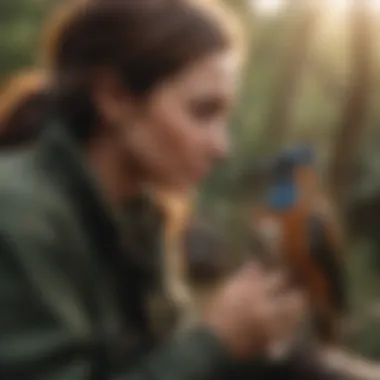
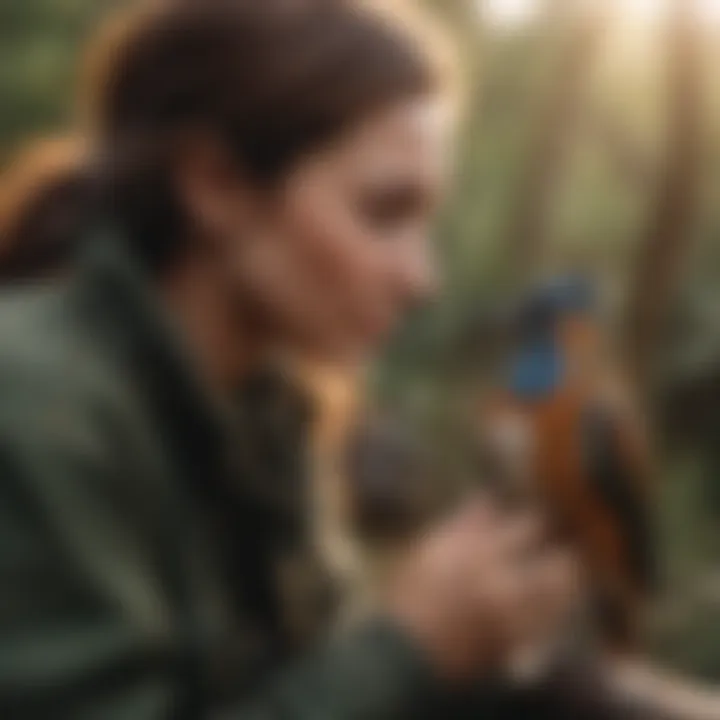
Creating a Safe Environment
Creating a safe environment is paramount for the well-being of pet birds, especially when they have the opportunity to spend time outside of their cages. This involves several key elements. First, a safe space protects birds from potential dangers. It is also crucial for their mental and physical health. When birds feel secure in their surroundings, they are more likely to explore and engage with their environment. This, in turn, contributes to their overall happiness and activity levels.
Designated Play Areas
Selecting Safe Locations
Selecting safe locations for birds to play is essential. A good area minimizes risks from other pets, children, or environmental hazards. Enclosed spaces like screened porches can offer both fresh air and safety. Such settings not only protect birds but also allow them to enjoy nature without the dangers of the outdoors. This controlled environment can reduce anxiety for both the pet and the owner.
However, it is important to recognize some of the disadvantages. These enclosed areas might limit access to natural light or outdoor stimuli, which birds often crave. Finding the right balance is key in ensuring a safe and engaging experience for them.
Providing Enrichment Items
Providing enrichment items is another facet of creating a safe environment. Accessories such as toys, perches, and climbing structures can stimulate birds mentally. Items like foraging toys encourage birds to engage and be active. Their innate curiosity drives them to explore these new elements, which helps in maintaining physical health.
However, not all items are suitable. Some materials can be toxic or hazardous to birds. Pet owners should prioritize bird-safe materials. Reading labels and conducting research on the safety of any item before introducing it is essential. This proactive approach helps in ensuring a safe play environment.
Monitoring Outdoor Experiences
Supervision during Playtime
Monitoring outdoor experiences adds another layer of security. Supervision during playtime ensures that birds are safe from environmental dangers and can also prevent them from escaping. An attentive owner can respond quickly to any signs of distress or issues. This active involvement provides an additional level of comfort for both the birds and their owners.
Scheduling playtimes in familiar settings fosters confidence in birds. Owners can choose locations where their pets feel at ease. The downside, however, could be that constant supervision can be demanding. It requires commitment and might limit owners' spontaneity in outdoor activities.
Understanding Stress Signals
Understanding stress signals in birds is vital for their welfare. Birds can communicate discomfort through various behaviors, such as excessive squawking or feather fluffing. Recognizing these signals allows owners to intervene before situations escalate. Learning how to read their body language is beneficial. It empowers owners to adjust playtime accordingly.
On the other hand, understanding stress signals does require time and practice. Not all owners may recognize the signs right away. Having a guide or expert advice can ease this process, ensuring that interactions remain positive and stress-free.
Challenges of Being Outside the Cage
Engaging pet birds outside their cages presents various challenges that are crucial for owners to understand. While the benefits are evident, the potential risks and the subsequent need for effective management strategies should not be overlooked. Recognizing these challenges allows pet owners to prepare adequately, ensuring that outdoor experiences are both enriching and safe.
Potential Risks
Predators and Environmental Hazards
One major concern for birds outside their cages is exposure to predators and environmental hazards. Birds can be preyed upon by not only domestic animals but also wildlife such as hawks, cats, and raccoons. The risk of a bird being attacked increases significantly in open spaces.
Environmental hazards also pose a threat. Birds may encounter sharp objects, toxic substances, or even hazardous weather conditions. These factors can lead to accidents or injuries. Understanding this aspect highlights the need for careful supervision and planning when allowing birds to roam outside their cages.
Key Characteristics:
- Awareness of local wildlife is essential.
- Protecting your bird from environmental dangers is necessary.
Benefits for the Article: This discussion clearly addresses a important aspect of bird safety outdoor. By highlighting these risks, owners are encouraged to take proactive steps to ensure their birds enjoy their time outside while minimizing danger.
Toxic Plants and Materials
Another critical aspect involves recognizing toxic plants and materials. Many plants, like oleander, azalea, and even some common household items like certain plastics, can be harmful or fatal to birds. This awareness is vital for owners, especially as many birds explore new areas once outside the cage.
Key Characteristic: Owners must distinguish safe areas from potentially dangerous ones.
Benefits for the Article: Highlighting the presence of toxic elements helps pet owners understand the need for a controlled environment when their birds are exposed to the outdoors. This knowledge can prevent many health issues and foster a safer experience.
Reintroducing to the Cage
After a period of exploration outside, reintroducing birds back to the cage can present its own set of challenges. Birds may resist returning, which can lead to anxiety for both the pet and the owner. Understanding how to facilitate this transition is crucial for maintaining a bird’s overall sense of security.
Managing Transition Anxiety
Managing transition anxiety involves recognizing that many birds feel stressed when moving from an open space back to the enclosure. This anxiety can manifest in behaviors such as pacing, excessive vocalization, or refusal to enter the cage.
Key Characteristic: Anxiety can be mitigated through gradual introductions or comfortable routines.
Benefits for the Article: Addressing this issue shows the importance of minimizing stress during re transitions. This can lead to happier, more well-adjusted birds.
Creating a Positive Reinforcement Strategy
Developing a positive reinforcement strategy is key to smoother transitions. This can mean rewarding birds with treats or praise when they return to their cage without resistance. Over time, birds learn that the cage is a safe space, fostering trust and reducing anxiety.
Key Characteristic: Using positive reinforcement creates a welcoming environment for birds.
Benefits for the Article: This approach is beneficial as it not only eases anxiety but strengthens the bond between the bird and the owner, making outdoor exploration overall a positive experience.
"Through understanding and addressing the challenges outside the cage, bird owners can significantly enhance the quality of life for their pets by ensuring safety and comfort in all environments."
Training for Outdoor Exploration
Training for outdoor exploration is a fundamental aspect to enhance your pet bird's life beyond the confines of the cage. This process not only promotes physical activity but also serves as a foundation for building trust between you and your bird. It requires careful consideration of various techniques that address the unique needs of avian companions and allows them to thrive in their environment.


One significant component of this training is harness training. Birds, particularly those not used to open spaces, can become overwhelmed by the sights and sounds around them. A harness provides a safe way to explore without the risk of flying away. It is vital that bird owners choose a well-fitted harness designed specifically for their bird species. This is to ensure comfort, minimizing any stress related to improper fitting. Moreover, starting the training indoors simplifies the process. Gradually, the bird can be acclimatized to wearing the harness, with positive reinforcement employed to help build their confidence.
Harness Training
Harness training starts with familiarization. Owners should allow their birds to interact freely with the harness before attempting to put it on. Leave the harness nearby or even in their cage to create a sense of comfort. After this initial period, gently introduce the harness by placing it on the bird briefly during playtime, rewarding them with treats or verbal praise. The aim is to foster positive associations with the harness.
Once the bird adjusts to wearing the harness indoors, the next step involves short appearances outside. It’s essential to start small, giving the bird exposure to outdoor experiences gradually. In addition, consider the safety of the environment. Avoid busy areas with loud noises and potential hazards. Choose calm spaces where your bird can enjoy new sights and sounds, making the experience enjoyable rather than stressful.
This method leads to a beneficial relationship for both owner and pet. As the bird becomes accustomed to the harness and the outdoors, it develops confidence. This confidence translates into richer experiences outside the cage and a deeper bond.
Gradual Exposure to New Environments
Alongside harness training, the concept of gradual exposure to new environments cannot be overlooked. This step is crucial for any bird owner aiming to expand their pet’s horizons effectively. Just like humans, birds can feel anxious when faced with unfamiliar surroundings. Hence, this gradual approach is designed to minimize stress and enhance adaptability.
Start by adding small changes in the familiar environment. For example, moving the bird’s perch to different spots in the room can be a first step. Take time to observe their behavior and ensure they feel comfortable. Incorporate outdoor elements into their world, like the sounds of nature or pet-safe plants. Then, you can progress to short outdoor sessions.
When exposed to the outdoors, ensure it is a calm environment. Begin with brief trips that last no more than a few minutes. Over time, increase the duration gradually. This exposure is not only beneficial for physical reasons, as in getting fresh air, but it also enhances problem-solving skills as the bird reacts to new stimuli.
Daily Routines Outside the Cage
Establishing a daily routine for pet birds outside the cage is vital. Predictable schedules foster a sense of security for birds. Birds thrive on consistency; knowing when playtime occurs can reduce stress. Allocating time each day for interaction can also enhance mental stimulation. A well-structured routine promotes physical health and engages birds, leading to improved overall well-being. Not only does this routine form a foundation for trust, but it also helps create a bond between the bird and owner.
Establishing a Schedule
Creating a daily schedule is essential. Start by determining the best time for interactions based on your bird’s behavior. Early mornings can be lively, while evenings may be quieter. Cater the schedule to your specific bird. For instance, species such as budgerigars may be more active at certain times compared to cockatiels. Consistency in timing trains birds to anticipate interaction, encouraging excitement and engagement.
"A bird accustomed to routine feels secure, leading to a happier, healthier life."
Variety in Activities
Variety in activities keeps birds mentally stimulated. Introducing new experiences prevents boredom. Rotating activities can also ensure birds are consistently engaged. Birds are naturally curious animals; providing diverse interactions can cater to this trait. Here are two engaging activities to consider:
Outdoor Foraging
Outdoor foraging mimics natural behaviors. It involves allowing birds to search for food in various environments. This activity encourages instinctive behaviors, strengthening the bird’s connection to its natural instincts. One key characteristic of outdoor foraging is the sensory experience it provides. Birds utilize sight, smell, and touch during the activity. This creates a fulfilling experience that promotes mental alertness.
However, take care when choosing safe locations. Some areas may contain toxic plants or hazards. It's crucial to supervise your pet during foraging.
Interactive Play Sessions
Interactive play sessions involve direct engagement between the bird and owner. This can include using toys, obstacle courses, or simple fetch games. Interactive play encourages physical activity and mental engagement. The key characteristic of these sessions is that they foster socialization. Birds learn to interact with humans, promoting trust and bonding.
Interactive play has its unique benefits, but it can also present challenges if the bird becomes overstimulated. Be observant of your bird’s behavior. Recognizing signs of fatigue or stress is necessary, as this can prevent negative experiences.
Long-term Benefits of Outside Time
Providing opportunities for pet birds to spend time outside their cages yields numerous long-term benefits. These advantages encompass not just the physical aspects of a bird's well-being but extend deeply into their mental and emotional health. Engaging a bird in its environment influences its overall temperament and relationship with caretakers, making the bond stronger and healthier.
Enhanced Trust and Socialization
One of the most significant aspects of allowing birds outside their cages is the enhancement of trust and socialization. When birds explore their environment alongside their owners, they begin to associate this freedom with positive experiences. The result is an increased trust in their caretakers. Birds learn that their handlers are sources of safety and adventure.
As trust builds, so does the willingness of a bird to interact with humans. This socialization is crucial for species that thrive on interaction, such as parrots. For instance, a cockatiel that frequently enjoys outdoor play may show fewer signs of distress when encountering new people or situations.
Moreover, birds exposed to varied situations develop adaptability. They become accustomed to different sounds, movements, and occasional surprises in their environment. Resulting from this exposure, birds often display less fearfulness, leading to a calm demeanor. An owners’ patience can be vital during this process, ensuring gentle guidance and support.
Improved Behavioral Management
Effective behavioral management is another substantial benefit of outdoor time. Birds that engage in physical activities tend to exhibit fewer behavioral problems. Without adequate stimulation, pet birds might resort to unwanted behaviors like excessive squawking or feather plucking. When birds receive ample opportunities for play and exploration, their energy levels become balanced, minimizing these issues.
Birds that spend more time outside their cages develop healthier coping mechanisms over time. This reduced anxiety contributes to better overall behavior. A parakeet exploring new settings outside its cage is more likely to focus on curiously pecking at objects rather than biting humans out of frustration or boredom.
Using outdoor play as a behavioral management tool involves establishing routines. Birds thrive on predictability. When owners set aside specific times for outdoor activities, birds begin to anticipate these sessions. This anticipation fosters excitement and prompts positive associations, leading to more desirable behaviors throughout the day.
"A bird's well-being hinges not only on its physical surroundings but also on the emotional environments created by its interactions with human companions."
Finale: Embracing Life Beyond the Cage
Engaging in life outside the cage is essential for the well-being of pet birds. It not only fulfills their natural instincts but also improves their overall health and mental stimulation. As discussed earlier, providing opportunities for exploration and play nurtures their physical strength and social behaviors. This section synthesizes the significance of these practices while emphasizing the need for responsible pet ownership.
By implementing the strategies outlined in this article, owners can witness profound changes in their birds' lives. Regular outdoor time fosters trust between birds and their owners. This bond is crucial for a harmonious relationship. Moreover, enhancing behavioral management becomes easier as exposure to various environments promotes adaptability. It's vital to remember that this transition should be managed carefully to minimize stress for the birds.
"Creating an enriching environment is not merely about expanding space, but it is about expanding possibilities for our feathered companions."
Overall, the investment of time and effort in facilitating outdoor experiences greatly enriches a bird's life. The benefits are numerous, ranging from physical fitness to improved levels of happiness that can be observed in their demeanor.
Summary of Key Takeaways
In summary, the article has highlighted several critical aspects regarding life outside the cage:
- Physical Health: Regular exercise and active play significantly enhance the physical well-being of pet birds.
- Mental Enrichment: A diverse range of stimuli helps reduce boredom, keeping birds mentally sharp and engaged.
- Social Bonds: Time spent outside fosters deeper connections between birds and their owners, improving trust and communication.
- Safety Considerations: It is essential to consider potential hazards and ensure a safe environment when allowing birds out of their cages.
- Training and Routine: Gradual acclimatization to outdoor experiences makes the transition smoother for both birds and owners.
Encouraging Responsible Practices
To ensure that bird ownership remains fulfilling and enriching, certain responsible practices should be emphasized:
- Educate Yourself: Understanding the unique needs of your avian companions is vital. Research different species and their requirements for outdoor time.
- Supervise Activities: Always keep an eye on your bird when it is outside its cage. This ensures their safety from potential dangers, such as predators or harmful substances.
- Create Enrichment Opportunities: Incorporate safe toys, branches, and other natural items when designing play spaces for your birds.
- Monitor Behavior: Watch for signs of stress or discomfort. Adjust the environment or activities as needed to suit your bird’s comfort.
- Gradual Introductions: Start with short outdoor sessions and gradually increase duration as your bird becomes more comfortable.
By implementing these responsible practices, owners can create a nurturing and safe experience that truly enhances the quality of life of their pet birds.















